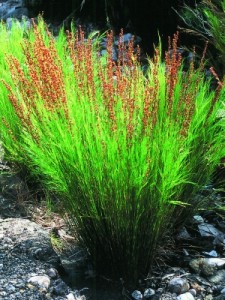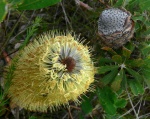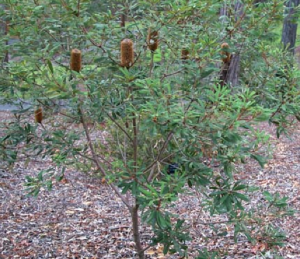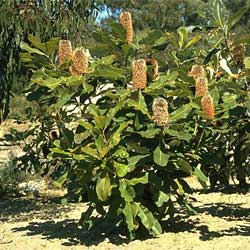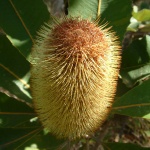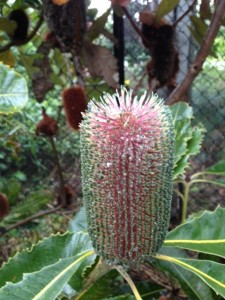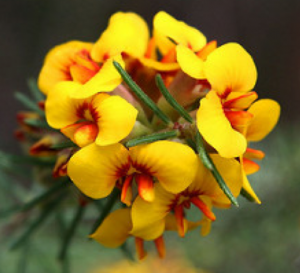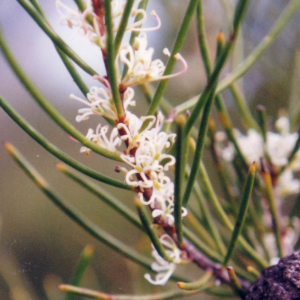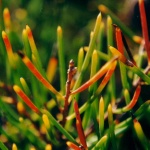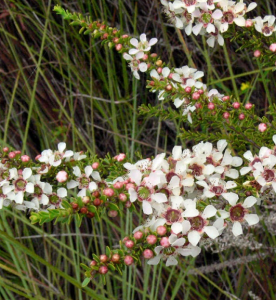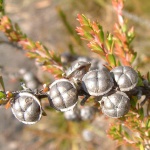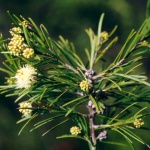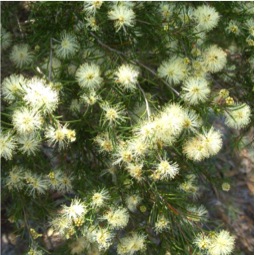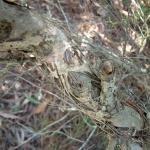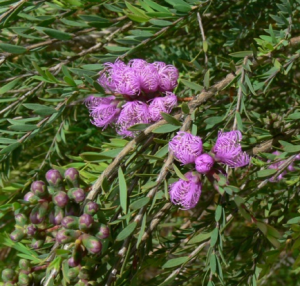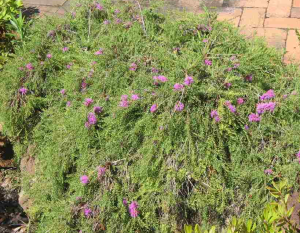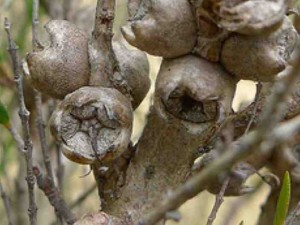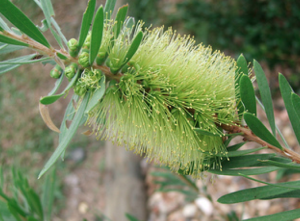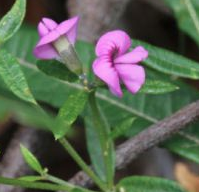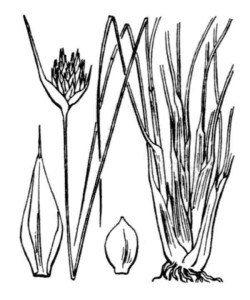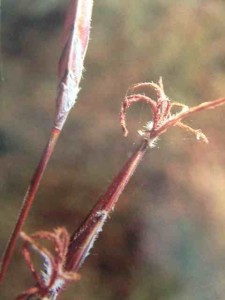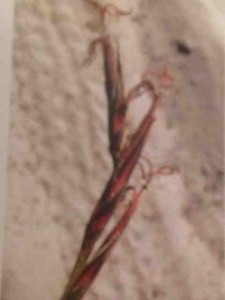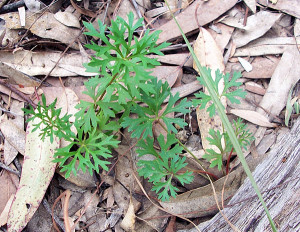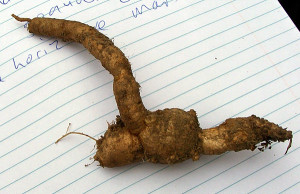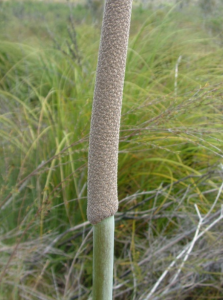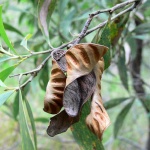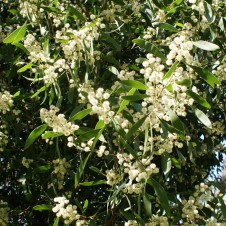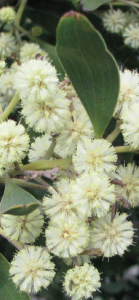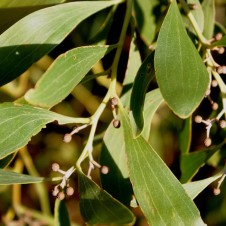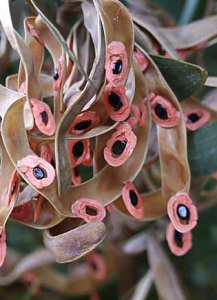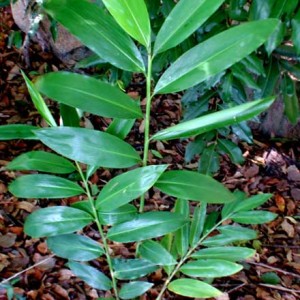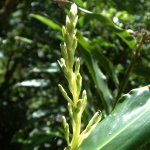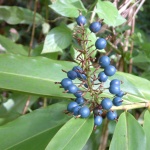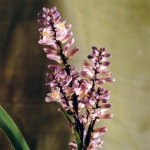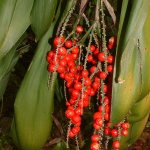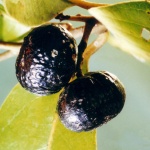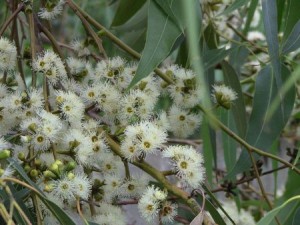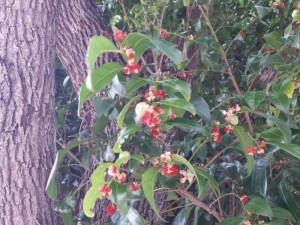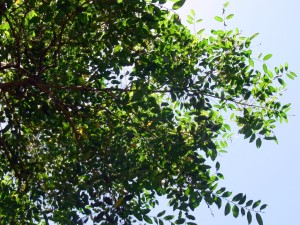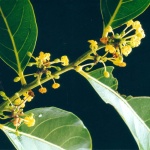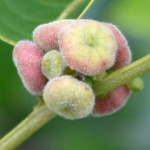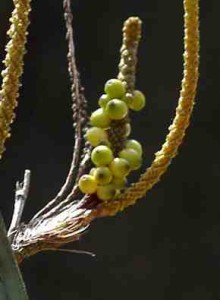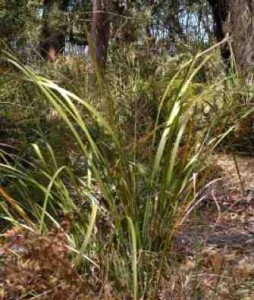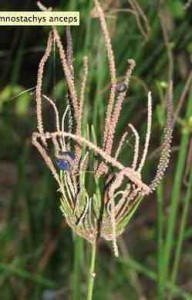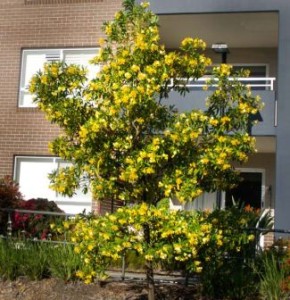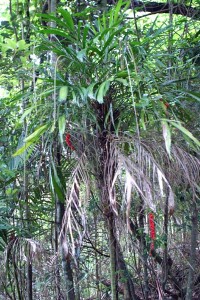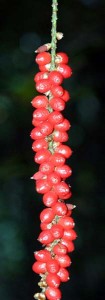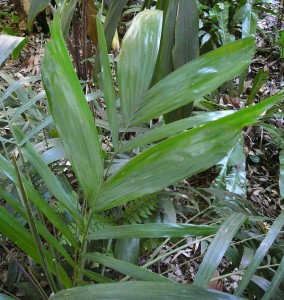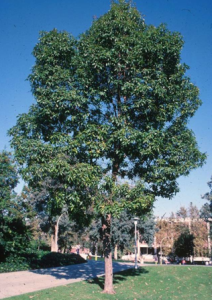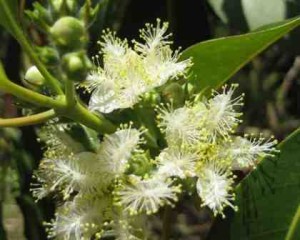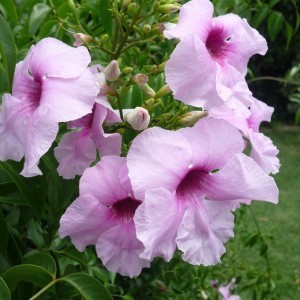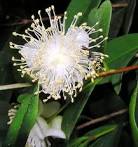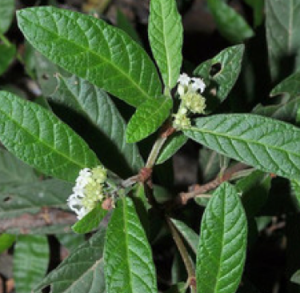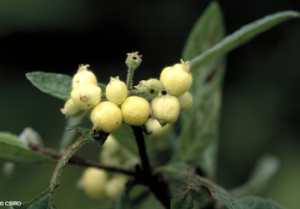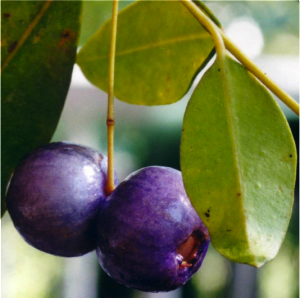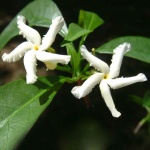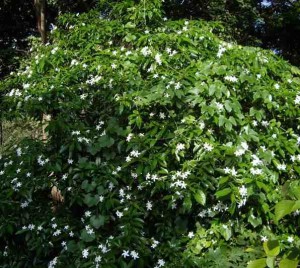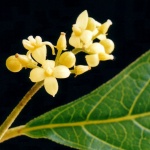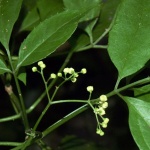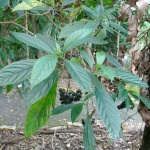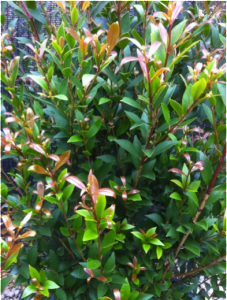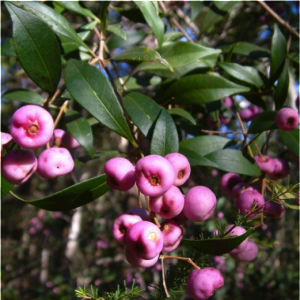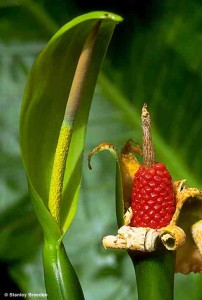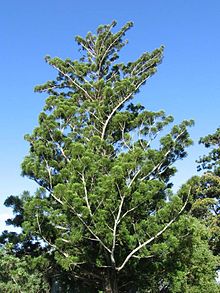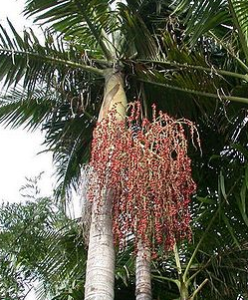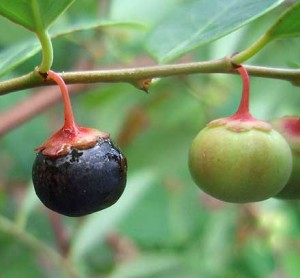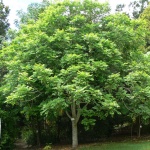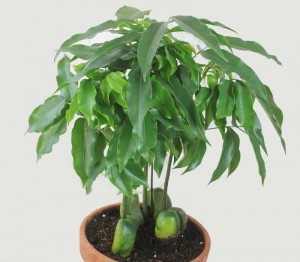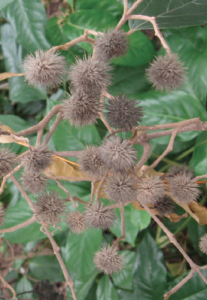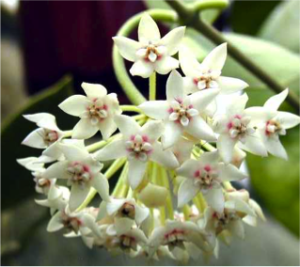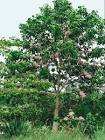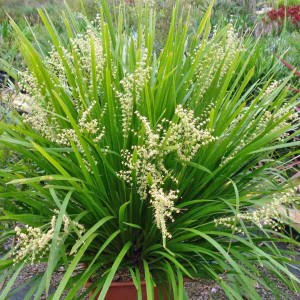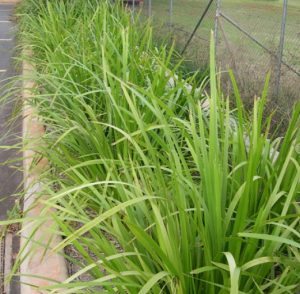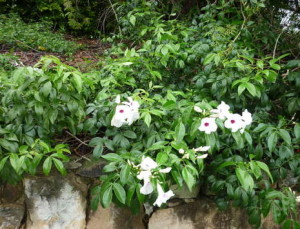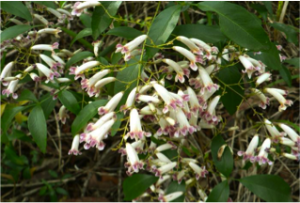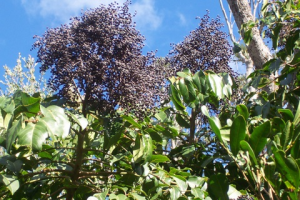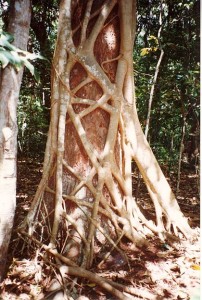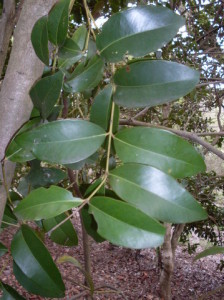WET HEATH PLANTS
Baloksion tetraphyllum (Swamp Foxtails)
Form/Size: Herb 1 to 1.5 metres tall by 1 metre spread
Aspect: Full sun/filtered sun
Soil: Moist
Description:
Bright green, erect stems with dense tufted foliage.
Male flowers are long brown spikes, female flowers are compact miniature cones – on separate plants.
Fantastic for cut flower arrangements.
Excellent understorey species in moist sandy soil.
Family: RESTIONACEAE
Banksia oblongifolia (Dwarf Banksia)
Form/Size: Shrub from 0.5 to 1.5 metres tall
Aspect: Full sun, part shade
Soil: Moist, well drained
Description:
Low spreading shrub with green serrated leaves & spectacular yellow-green cylindrical flowers to 10 cm tall
in Autumn/Winter.
Young foliage is rusty brown.
Bird attractant.
Flowers produce nectar which is Bush Tucker.
Fantastic small coastal garden shrub.
Family: PROTEACEAE
Banksia robur (Swamp Banksia)
Form/Size: Shrub 1.5 metre tall, 1 metre wide
Soil/Conditions: Adaptable
Aspect: Full sun
Description:
Upright spreading habit.
Serrated leathery leaves to 30cm long
Blue-green to lime coloured flower spikes to 20cm long in Dec/May
Prefers wetter areas.
Frost hardy.
Family: PROTEACEAE
Special Features:
Interesting seed cones that remain on the shrub.
Iconic architectural plant.
Bird attracting.
Flower produces nectar that is bush tucker
Fantastic coastal garden shrub
Dillwynia floribunda (Showy Parrot Pea)
Form/Size: Shrub to 1.5 metres
Aspect: Full sun/filtered sun
Soil: Adaptable
Description:
Dense shrub with thin bright green leaves which gets covered in lovely yellow flowers late Winter to Spring.
Responds well to pruning after flowering.
Excellent gap-filler or flowering feature shrub.
Family: BAUERACEAE
Hakea actites (Wallum Hakea)
Form: Shrub 2.5 metre tall & 1 metre wide
Soil: Adaptable
Aspect: Full sun/part shade
Description:
Erect, multi-branched dense shrub.
10 cm long needle-like foliage.
White to pink Grevillea-like flowers in Winter/Spring
Unusual woody pods.
Hardy special and excellent screening plant.
Family: Proteaceae
Leptospermum liversidgei (Lemon-Scented Teatree)
Form: Shrub 1-2.5 metre tall & 1 metre wide
Soil: Adaptable
Aspect: Full sun
Description:
Attractive erect shrub.
Bright green strongly lemon-scented leaves,
Small white or sometimes pink flowers in Summer.
Seeds become woody & remain on plants for
years.
Tolerates poorly drained soils & frost hardy.
Family: Myrtaceae
Special Features:
Great small dense garden shrub.
Suitable near coast.
Ground Parrot habitat.
Melaleuca nodosa (Prickly-leaf Paperbark)
Form: Spreading shrub or tree to 7 metres (usually less)
Aspect: Full sun
Soil/Conditions: Adaptable
Description:
Shrub with papery layered bark, drooping stems and pointed leaves.
Masses of creamy-yellow flowers in spring and summer.
Popular screen plant for areas exposed to salt spray.
Very hardy & frost tolerant.
Important pollen source for bees.
Family: Myrtaceae
Melaleuca thymifolia (Thyme Honey Myrtle)
Form: Shrub 1 metre tall
Soil: Adaptable
Aspect: Full sun
Description:
Very popular flowering shrub.
Bright pink, sometimes purple flowers in Spring.
Very hardy, good seaside plant.
Tolerates wet feet.
Family: Myrtaceae
Special Features:
Melaleuca pachyphylla (Wallum Bottlebrush)
Form: Shrub 1-1.5 metres tall
Soil: Adaptable
Aspect: Full sun
Description:
Very hardy small shrub for home gardens.
Bright red flower brushes to 10 cm long in Spring/Summer/Autumn.
Green form also available
Prune for more compact and smaller plant.
Family: Myrtaceae
Special Features:
Good seaside plant
Flowers produce nectar which is bush tucker
Fantastic small coastal garden shrub
Tolerates wet feet
Attracts birds, bees and butterflies.
Mirbelia rubifolia (Wallum Mirbelia)
Form/Size: Small shrub to 50 cm tall
Aspect: Full sun
Soil Sandy
Description:
Open shrub with pretty pink-purple flowers 8mm wide in late winter to early summer.
Excellent small shrub for edging, colour, and as an in-fill plant.
Family: Fabiaceae
Schoenus calostachys (A Bogrush)
Form: Sedge to 1 metre tall
Aspect:
Soil: Wet, swampy
Description:
Long, rigid, deeply grooved stems.
Nuts blackish brown.
Family: Cyperaceae
Sowerbaea juncea (Vanilla Lily)
Form: Lily to 40 cm tall
Aspect: Sunny
Soil: Moist
Description:
Leaves form blue-green, grasslike clumps rather like chives.
The roots are fibrous-fleshed and lack any tubers.
Flowers are borne in dense heads of more than 20 individual flowers on a single, unbranched stem.
Delicate mauve shade with pink bracts, and have a delicious vanilla perfume.
Flowering occurs in spring, and a field of vanilla lilies is a sight to behold!
Special Features: It can be grown as a container plant, or in a rockery, or a terrarium, and is useful around the edges of a pond. Unfortunately it is only rarely seen in cultivation.
Family: Asparagaceae
Trachymene incisa (Wild Carrot, Wild Parsnip)
Form: Perennial herb to 8o cm tall
Aspect: Open sunny
Soil: Sandy, Wet, Rock crevices.
Family: Apiaceae
Description:
Thick perennial rootstock and is sparsely hairy to almost hairless.
The leaves mostly emerge form the base of the plants to 13 cm long.
Flowers are produced in umbels. Petals 0.9–2.2 mm long, white or rarely pink.
Fruit broad ovate, 2.4–3.6 mm long, and brown
Special Features: Bush food: thick juicy taproots edible, raw or cooked.
Xanthorrhoea fulva (Wallum Grass Tree)
Form: Grass tree to 2 metres tall without trunk
Soil / Conditions: Adaptable/Moist
Aspect: Full Sun
Description:
Attractive long green shiny foliage.
Flowers late winter to spring.
Grows as a large tuft in sandy soils without a trunk.
Great for smaller gardens in a sunny position.
Flower spike still gets to 2 metres tall.
Family: Xanthorrhoeceae
Special Features:
Attracts birds & bees.
WET EUCALYPT FOREST
Acacia disparrima (Hickory Wattle)
Form: Tree 2 to 15 metres tall.
Aspect: Full sun/part shade
Soil: Adaptable
Description:
Dark grey bark, blue/green foliage, masses of cream or yellow flower spikes in Jan-May.
Flowers attract birds, Fiery Jewel & Common Imperial Blue butterflies & supply pollen for bees.
Seeds attract parrots.
Hardy, fast growing and adaptable.
Acacia melanoxylon (Blackwood)
Form: Tree to 20 Metres Tall
Aspect: Full sun/ Semi-shade
Soil/Conditions: Adaptable, prefers Moist
Description:
Rounded Habit
Cream flowers in Spring
Unusual coiled / twisted seed pods
Family: Mimosaceae
Special Features:
Good for Erosion Control and Revegetation
Frost Tolerant
Long invasive root run
Valuable Timber Tree
Host tree for indigenous Butterfly Larvae
Aboriginals used bark and twigs for fish poison as a means of fishing
Alpinia caerulea (Native Ginger)
Form: Perennial herb to 2 metres tall by 1.5 metres wide
Aspect: Full Shade/ Filtered Sun
Soil: Adaptable
Description:
Erect stems, large light green leaves, white flowers in Summer followed by bright blue edible fruit.
Attracts birds.
Young rhizome tips, buds & roots eaten raw taste like ginger.
Good understorey feature plant, creekside plant, or around a pond.
Clumping.
Family: Zingiberaceae
Carex apressa (Tall Sedge)
Form: Sedge to 1.5 tall by 0.8 metres wide
Soil / Conditions: Adaptable
Aspect: Full sun / Filtered Sun
Description:
Long narrow leaves.
Minute greenish-brown flower on spikes similar to foxtails.
Likes moisture & will tolerate roots in water.
Frost resistant, drought tender.
Family: Cyperaceae
Special Features:
Cordyline rubra (Red Palm Lily)
Form: Palm lily 2 to 3 metres tall.
Aspect: Full shade/ Filtered sun
Soil: Moist, well drained
Description:
Erect stems with leaves up to 60cm long, small, white-purple flowers on long sprays in Spring/Summer & bright
red berries.
Excellent indoor plant.
Hardy.
Butterfly host.
Grows in full shade.
Family: Asparagaceae
Cryptocaria glaucescens (Jackwood)
Form: Tree to 30 metres tall
Aspect: Full sun, part shade
Soil: Adaptable
Description:
Glossy aromatic leaves, small creamish-green flowers in October-December & black berries March-June which attract birds.
Hosts Blue Triangle & Macleay’s Swallowtail butterflies.
Great feature rainforest tree with foliage growing low to the ground.
For bigger yards.
Family: Lauraceae
Eucalyptus robusta (Swamp Messmate)
Form: Tree to 25 metres tall.
Aspect: Full sun
Soil: Adaptable, moist
Description:
Primary food source for Koalas.
Grows close to the coast.
Bark rough and persistent to the smaller branches.
Drooping foliage & white flowers in autumn & winter.
Pale-headed Rosellas eat seed.
Koala & glider food & shelter tree.
For the large backyard.
Family: Myrtaceae
Glochidion ferdinandii (Cheese Tree)
Form: Bushy shrub or tree to 10 metres
Aspect: Full sun.
Soil:Adaptable, moist.
Description:
Dark green canopy of foliage.
The bark is light coloured and slightly flaky in appearance.
Flowers appear between July and December, they are small and greenish –yellow in colour .
Fruit is a characteristically pumpkin shaped or “edam” cheese shaped up to 20mm in diameter, splitting when ripe to reveal seeds covered in a bright red- orange aril within.
Maybe semi-deciduous in winter.
Family: Phyllanthaceae
Special Features:
Fruits are eaten by several bird species, including the, Lewin’s Honeyeater, Olive-backed Oriole, rainforest pigeons and doves, and parrots.
Food source for butterfly larvae of the Shining Pencil-blue, and the Common Oak-blue
Glochidion sumatranum (Umbrella Cheese Tree)
Form: Tree 10-15 metres tall
Aspect: Full sun/filtered sun
Soil/Conditions: Moist
Description:
Graceful habit, umbrella shaped canopy, attractive glossy foliage with pink new growth.
Green-yellow perfumed flowers in Oct/Dec.
Pink rounded fruit shaped like a European cheese wheel.
Very fast growing.
Excellent pioneer tree for revegetation.
Attracts Lewin’s Honeyeater.
Family: Phyllanthaceae
Gymnostachys anceps (Settler’s Flax)
Form: A tufted herb up to 2m tall with creeping rhizome.
Aspect: Low sun to dappled light
Soil: Dry betweeen watering to constantly moist
Description:
Leaves are basal, tough, linear, strap-like 1-2m long and 25mm wide. The leaves are strongly veined and channelled.
Flowers are small, green, stalkless and 4-lobed, arranged in slender spike 15cm long. The spikes are grouped in clusters at the tips of erect flattened stems 1-2m high. The stamens have bright yellow anthers. The flowering stems are longer than the leaves. Flowers mainly October-December.
Fruit is blue-black, shiny, ovoid berry, 1-1.5cm long.
Family: Araceae Subfamily: Gymnostachydoideae
Hymenosporum flavum (Native Frangipani)
Form: Tree to 20m – less in cultivation
Aspect: Full sun/filtered sun
Soil/Conditions: Moist, adaptable.
Description:
Very fast growing tree with fragrant yellow flowers in Spring.
Upright growth habit, responds well to pruning.
Excellent tree for narrow areas, such as between buildings and along fence lines.
Family: Pittosporaceae
Linospadix monostachya (Walking Stick Palm)
Habit: Palm to 3 metres
Aspect: Filtered sun.
Soil: Adaptable/ Moist
Description:
Small palm that has a mature form closer to a cordyline shape.
Uncommon.
Distinctly ringed trunk, used by physically disabled service people as walking sticks after the First World War.
Edible red fruit to 10mm on spikes.
Prefers sheltered position.
Family: Arecaceae
Kennedia rubicunda (Running red pea)
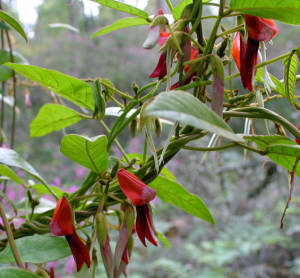
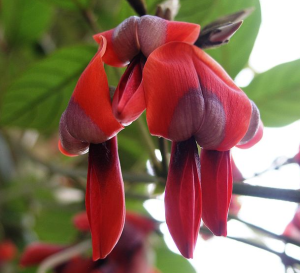
Form: Vine – climbing or prostrate to 2 metres
Soil / Conditions: Adaptable / Well-drained
Aspect: Full Sun/Part Shade
Description:
Scrambling or prostrate plant.
Slender stems & patterned, dark green leaves.
Masses of attractive red flowers in Winter and Spring.
Family: Fabaceae
Special Features: Fruit is silky, hairy pods.
Aspect: Full sun/filtered sun
Soil: Adaptable
Description:
Single grey trunk.
Shiny green, fan shaped leaves to 1.8m wide & 4m long.
Creamy white flowers & black fruit.
Tolerates full sun, salt air, and a variety of soils including sand.
Special features:
Attracts birds & butterflies.
Lophostemon confertus (Queensland Brushbox)
Form: Medium tree 10-15 m in height x 6-12 m width
Aspect: Full sun
Soil: Adaptable
Description:
Leaves thick, ovate, dark green and glossy. above, paler beneath,to 15cm long.
Flowers white, occurring in three’s, generally inconspicuous in southern Australia.
Fruit a woody bell shaped capsule to 1cm.
Bark smooth, sometimes lustrous, beige coloured, seasonally peeling in flakes revealing coppery orange to brown tones.
Special Features:
Moderate to long lived species.
Requires irrigation to establish.
Transplants easily.
Rarely requires formative pruning to develop good branch structure. Responds well to pruning.
Fire retardant.
Generally free of any serious pests or diseases.
Flowers attract bees.
Produces a woody fruit capsule that can create trip hazard on hard surfaces.
Leaf litter slow to break down.
Good street tree or modest sized specimen tree for parks.
Macaranga tanarius (Macaranga)
Form: Small tree to 6 metres tall by 4metres wide
Aspect: Full sun/Filtered sun
Soil/Conditions: Adaptable
Description: Pioneer plant in areas of regrowth, very fast growing with large heart-shaped leaves.
Male and female flowers on separate plants.
Sticky green fruit capsules with black fruit that birds love.
Excellent for revegetation and filling bare areas to provide cover for other plants.
Family: Euphorbiaceae
Pandorea jasminoides (Bower of Beauty)
Form: Vine up to 6 metres long
Aspect: Full sun/ Filtered sun
Soil: Adaptable
Description:
Hardy, vigorous plant with dark green bushy foliage & showy pink flowers (sometimes white) Spring & Summer.
Seed pods attract birds.
Used as a nesting site by small birds.
Tolerates salt spray.
Family: Bignoniaceae
Special Features:
Suitable for trellis, groundcover, wall overhang, or pergola.
Pilidiostigma rhytispermum (Plum Myrtle)
Form: Shrub 3 to 5 metres tall
Aspect: Full shade, filtered sun
Soil: Adaptable, Moist
Description:
Bushy habit, dark green foliage with attractive new growth, pretty white flowers in Winter & Spring, followed by purplish-black succulent berries.
Suitable for growing along creek banks.
Excellent shade loving shrub.
Family: Myrtaceae
Psychotria loniceroides (Hairy Psychotria)
Form: Shrub 5 metres tall
Soil: Moist/Adaptable
Aspect: Shade/Semi-shade
Description:
Open rounded habit.
Evergreen perennial.
Light green hairy elliptical leaves.
White flowers to 11 mm in Spring.
Yellow or white fruit to 8mm.
Family: Rubiaceae
Special Features:
Fruit-earing bird attracting
Understorey shrub
Edible but unpalatable fruit.
Syzygium oleosum (Blue Lilly-Pilly)
Form: Small Tree or Large Shrub to 6 metres tall by 3 metres across.
Aspect: Full sun/Filtered sun
Soil/Conditions: Sandy/Adaptable
Description:
Ornamental & fast growing, glossy dark green to yellow foliage, leaves smell lemony when crushed, creamy-white flowers in Summer.
Tasty edible purplish-blue fruit in March-May makes good jam.
Good windbreak or street tree specimen.
Tolerates south-east winds and salt spray.
Special Features:
Fruit is nice as a jam.
Attracts birds.
Tabernaemontana pandacaqui (Banana Bush)
Form: Shrub to 3 metres tall
Aspect: Full shade, filtered sun
Soil: Adaptable, Moist
Description:
Attractive semi-deciduous bush, leaves have milky sap.
Pretty scented white flowers in Spring & Summer, and fascinating but inedible (toxic) orange, banana-shaped fruit.
Dense shrub for shady areas of the garden. Can be pruned.
Family: Apocynaceae
RAINFOREST
Abrophyllum ornans (Native Hydeangea)
Form/Size: Shrub or small tree to 5 metres tall
Aspect: Full sun/filtered sun
Soil: Moist
Description:
Large leaves to 20cm long, toothed at tips, sprays of tiny perfumed greenish-yellow flowers in Spring.
Black berries.
Suitable for heavy shade.
Grown for its attractive foliage.
Good indoor plant.
Family: Grossulariaceae
Acmena smithii var minor (Small-leaved Lilly-Pilly)
Form: Shrub to 4 metres tall by 1.5 metres across.
Aspect: Full sun/part shade
Soil/Conditions: Adaptable
Description:
Lovely bushy habit, glossy medium-green leaves with pink flushes, tiny white fluffy flowers in Summer and attractive
edible pink fruit.
Frost tolerant and salt spray resistant.
Tolerates South-East winds.
Excellent screening and hedging plant.
Family: Myrtaceae
Special Features:
Fruit is nice raw or as a jam.
Alocasia brisbanensis (Cunjevoi Lily)
Habit: Lily up to 2 metres tall by 1 metre wide
Aspect: Full shade/ Filtered sun
Soil: Moist
Description:
Very ornamental habit, large (up to 70cm long) “elephant ear” light green leaves on long fleshy stems.
Highly fragrant creamish flowers followed by red berries.
Plant sap is toxic.
Family: Araceae
Special Features:
Reputed remedy to the effects of the Stinging Tree.
Araucaria cunninghamii (Hoop Pine)
Form: Tree 40-50metres tall
Aspect: Full sun/filtered sun
Soil: Moist
Description:
Stately connifer with straight trunk & open crown, rough bark and seed cones to 10cm long.
Cones attract birds.
Wood is habitat for Jewel beetles.
Slow growing, excellent timber tree for indoor joinery, plywood and furniture.
Drought & salt-spray resistant.
Family: Araucariaceae
Archontophoenix cunninghamiana (Bangalow Palm)
Form: A large-sized palm generally reaching 20-25 meters in height.
Aspect: Full sun/ Part shade
Soil: Moist
Description:
New leaves of the bangalow palm are often in pink/red tones.
It small red fruit is inedible.
The name bangalow is aboriginal for ‘water carrying basket’; the crown-shaft can be fashioned, with a few deft folds and tucks into a watertight vessel, the petiole used as the handle.
Propagation is by seed.
Family: Arecaceae
Breynia oblongifolia (False Coffee Bush)
Form: Shrub to 3 metres tall
Aspect: warm low sun to dappled light
Soil: Moist
Description:
Leaves are soft, elliptical (oblong) to 2 cm. New growth rust coloured.
Flowers are inconspicuous, on the undersides of the stems at the leaf axils, each with a diameter of about 3 mm. Flowers in May to July.
The fruit are round berries, diameter to 0.5 cm. Initially whitish green they turn red then black as they ripen. Resemble tiny apples. Edible.
The foliage is food for the caterpillars of several Australian butterflies and moths.
Family: Euphorbiaceae
Canastospermum australe (Black Bean)
Form: Tree to 40 metres tall
Aspect: Full sun/ Part shade
Soil: Adaptable/ Moist
Description:
This slow-growing Australian tree has a spreading crown and large glossy leaves, each with 11-15 leaflets.
The orange or yellowish pea-shaped flowers are borne in clusters on the branches so that they are partially hidden by the leaves.
The pods are large and woody containing 2-3 large brown seeds which are highly toxic unless treated prior to roasting.
The wood is dark and highly prized for cabinet work.
Commersonia bartramia (Brown Kurrajong)
Form: A small tree that grows up to 20 m tall
Aspect: Full Sun/ Part Shade
Soil: Moist
The fruit is a dry capsule that grows up to 2 cm in diameter that splits into five segments each of which contain 2-6 seeds. The burr-like capsule is covered with soft star-shaped hairs that are 3-8 mm long.
Elaeocarpus grandis (Blue Quandong)
Form: Tree to 24 metres
Aspect: Full Sun
Soil: Moist well drained.
Description:
Fast growing tree.
Branches open and almost horizontal.
Develop a large buttressed trunk and have a dark grey to brown smooth bark.
For such a large tree, the Elaeocarpus grandis has a surprisingly petite flower. Small white clusters of flowers gather on the undersides of the branches, their small size is a direct contrast to the enormity of the tree. Fairy Petticoats, which is an apt description for the delicacy of the flowers is another common name for this tree.
Special Features:
Timber: Cabinet timber, pale, interior use and cabinet making, racing sculls, oars, aircraft construction.
Seeds used to make jewellery.
Bush food. Fresh Fruit eaten raw.
Bird attracting. Favourite food of fig birds and Fruit pigeons.
Hoya australis (Native Hoya, Wax Flower)
Form: Twining Vine to 6 Metres Tall
Aspect: Full Sun / Semi-Shade
Soil/Conditions: Moist, Well Composted
Description: Perennial Vine with fleshy leaves
White / Pale Pink waxy flowers in Spring. Perfumed flowers
Family: Apocynaceae
Special Features:
Host to Common Crow Butterfly
Suitable for Indoors / Pots
Bird attracting
Mellicope elleryana (Pink Euodia)
Form/Size: Tree to 20 metres tall (usually 10 metres in cultivation)
Aspect: Full sun/filtered sun
Soil: Moist, adaptable
Description:
Soft & corky whitish bark,
Beautiful glossy green open foliage,
Bright pink flowers in Summer which sprout all along the branches.
Dark brown fruit with black seeds which attract lorikeets.
Hardy, very fast growing.
Great feature tree, shade tree & ornamental tree for larger gardens.
Lomandra hystrix (Green Mat-Rush, Slender or Creek Mat-Rush)
Form: Sedge to 1.5 metres tall by 1.5 metres wide
Soil / Conditions: Adaptable
Aspect: Full sun / Part Shade
Description:
Long arching dark green leaves forming large tufts.
Tiny perfumed cream flowers on spikes.
Extremely tough & hardy, drought & frost tolerant.
Good soil binder on embankments and roadsides.
Family: Laxmanniaceae
Special Features:
Attracts butterflies.
Pandorea pandorana (Wonga Wonga Vine)
Form: Scrambling / Climbing Vine to height of Support
Aspect: Full Sun / Semi-Shade
Soil/Conditions: Moist, Well Drained
Description:
Vigorous Climbing Habit
Sweet smelling White tubular flowers with Purple or Red throats in Spring
Green glossy leaves
Young growth resembles ferns
Family: Bignoniaceae
Natural Habitat: Rain Forest
Special Features:
Unusual winged seeds
Will quickly climb tall trees with only stems showing lower down
Polyscias elegans (Celery Wood)
Form: Tree to 15m, very fast growing.
Aspect: Full Sun / Semi-Shade
Soil/Conditions: Higher rainfall areas
Description:
Pioneer species quickly filling gaps caused by vegetation disturbance.
Saplings often unbranched. Wood white, very soft and light.
Slender fast growing, celery scented timber.
Generally regarded as a rather inferior species for the production of timber.
Family: Araliaceae
Natural Habitat:
A characteristic tree of disturbed rain forest in the higher rainfall areas but also grows as a canopy tree in monsoon forest and drier rain forest
Special Features:
The fruit is eaten by a large variety of birds, including brown cuckoo dove, Australasian figbird, green catbird, Lewin’s honeyeater, olive-backed oriole, pied currawong, paradise riflebird, rose crowned fruit dove, silvereye, superb fruit dove, topknot pigeon and wompoo fruit dove.
Acmena hemilampra (broad-leaved lilly pilly)
Form: Tree 8-20m tall.
Aspect: Full Sun
Soil/Conditions: Moist, well drained, tolerates salt spray
Description:
Glossy dark green leaves with red new growth,
greyish flaky trunk,
fluffy white flowers in spring and summer,
white succulent edible fruit.
Family: Myrtaceae
Natural Habitat: Rain Forest
Special Features:
Excellent feature tree or shade tree.
Planted in Birtwill St, Coolum as street tree.
Coming Soon:
